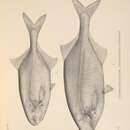Diagnostic Description
provided by Fishbase
Diagnosis: dorsal fin between one half and twice the anal fin length; mouth inferior situated below the eyes (Ref. 28714). Body height > 25% of SL (Ref. 28714), 2.6-3.2 times in SL (Ref. 2915, 81274). Anal fin base 3.1-3.4 times in SL; caudal peduncle height 16.8-18.7 times in SL; eye diameter 3.5-4.5 times in head length; uniform silvery color (Ref. 2915, 81274). Upper jaw with 13-19, lower jaw with 22-29 teeth; subspecies P. b. bane has 29-34 rays in dorsal fin and 31-38 in anal while P. b. comoensis has a lower average number of rays, 25-30 in dorsal and 32-36 in anal fin; scale counts: 40-44 in a longitudinal line and 12 around caudal peduncle; ratio standard length/caudal-peduncle depth in P. b. comoensis: 17.0-18.0 (Ref. 81274).Coloration: uniform silvery (Ref. 2915, 81274).
Migration
provided by Fishbase
Potamodromous. Migrating within streams, migratory in rivers, e.g. Saliminus, Moxostoma, Labeo. Migrations should be cyclical and predictable and cover more than 100 km.
- Recorder
- Crispina B. Binohlan
Morphology
provided by Fishbase
Dorsal spines (total): 0; Dorsal soft rays (total): 25 - 35; Analspines: 0; Analsoft rays: 31 - 38
Trophic Strategy
provided by Fishbase
Feeds mostly on insects (Ref. 6160).
Biology
provided by Fishbase
Inhabits open water and vegetated areas of lakes, lagoons and irrigation canals; females grow larger and are more frequently caught than males (Sudan); chiefly insectivorous, feeding on the bottom and in vegetation (Ref. 28714). Affinities: P. ansorgii, differ only by the small eyes, the thick caudal peduncle, numerous teeth on lower jaw and the uniform silvery color (P. ansorgii has a spot on the dorsal fin).
- Recorder
- Crispina B. Binohlan
Importance
provided by Fishbase
fisheries: ; aquarium: commercial
- Recorder
- Crispina B. Binohlan
Petrocephalus bane
provided by wikipedia EN
Petrocephalus bane is a species of elephantfish native to Africa where it occurs in the basins of the Nile, Bénoué and Volta rivers and the Chad Basin. It prefers relatively still waters of lakes, irrigation canals and lagoons. This species can reach a length of 20 centimetres (7.9 in) SL. It can also be found in the aquarium trade.[1]
References

- license
- cc-by-sa-3.0
- copyright
- Wikipedia authors and editors
Petrocephalus bane: Brief Summary
provided by wikipedia EN
Petrocephalus bane is a species of elephantfish native to Africa where it occurs in the basins of the Nile, Bénoué and Volta rivers and the Chad Basin. It prefers relatively still waters of lakes, irrigation canals and lagoons. This species can reach a length of 20 centimetres (7.9 in) SL. It can also be found in the aquarium trade.
- license
- cc-by-sa-3.0
- copyright
- Wikipedia authors and editors

